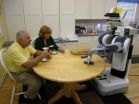(Press-News.org) EAST LANSING, Mich. — Warmer oceans in the future could significantly alter populations of phytoplankton, tiny organisms that could have a major impact on climate change.
In the current issue of Science Express, Michigan State University researchers show that by the end of the 21st century, warmer oceans will cause populations of these marine microorganisms to thrive near the poles and may shrink in equatorial waters. Since phytoplankton play a key role in the food chain and the world's cycles of carbon, nitrogen, phosphorous and other elements, a drastic drop could have measurable consequences.
"In the tropical oceans, we are predicting a 40 percent drop in potential diversity," said Mridul Thomas, MSU graduate student and one of the co-authors. "If the oceans continue to warm as predicted, there will be a sharp decline in the diversity of phytoplankton in tropical waters and a poleward shift in species' thermal niches, if they don't adapt to climate change."
Thomas co-authored the study with fellow MSU graduate student Colin Kremer, plant biology, and their faculty mentors Elena Litchman, MSU zoologist, and Christopher Klausmeier, MSU plant biologist. The team, which conducted its research at MSU's Kellogg Biological Station, explained that since phytoplankton play a key role in regulating atmospheric carbon dioxide levels, and thus, global climate, this shift could cause significant change.
The microorganisms use light, carbon dioxide and nutrients to grow. Although phytoplankton are small, they flourish in every ocean, consuming as much carbon dioxide through photosynthesis as all the terrestrial plants combined.
Water temperatures strongly influence their growth rates. In fact, phytoplankton in warmer equatorial waters can grow much faster than their cold-water cousins. With worldwide temperatures predicted to increase over the next century, it's important to gauge phytoplankton's reaction and what will happen to the carbon that they currently carry to the ocean floor.
The researchers were able to show that phytoplankton have adapted to local current temperatures. Based on projections of ocean temperatures in the future, however, many phytoplankton may not adapt quickly enough to changes in their current environment. Since phytoplankton can't regulate their temperatures or migrate, they may suffer significantly limited growth and diversity, Kremer said.
Being able to forecast the impact of these changes will be a useful tool for scientists around the world, said David Garrison, program director in the National Science Foundation Division of Ocean Sciences.
"This is an important contribution to predicting plankton productivity and community structure in the oceans of the future," he said. "The work addresses how phytoplankton species are affected by a changing environment, and the really difficult question of whether evolutionary adaptation to those changes is possible."
###
This research is funded in part by the National Science Foundation and MSU's BEACON Center for the Study of Evolution in Action.
Michigan State University has been working to advance the common good in uncommon ways for more than 150 years. One of the top research universities in the world, MSU focuses its vast resources on creating solutions to some of the world's most pressing challenges, while providing life-changing opportunities to a diverse and inclusive academic community through more than 200 programs of study in 17 degree-granting colleges.
Small organisms could dramatically impact world's climate
2012-10-26
ELSE PRESS RELEASES FROM THIS DATE:
Individual gene differences can be tested in zebrafish
2012-10-26
HERSHEY, Pa. -- The zebrafish is a potential tool for testing one class of unique individual genetic differences found in humans, and may yield information helpful for the emerging field of personalized medicine, according to a team led by Penn State College of Medicine scientists. The differences, or mutations, in question create minor changes in amino acids -- the building blocks of DNA -- from person to person. Zebrafish can be used as a model to understand what biological effects result from these genetic mutations.
Personalized medicine uses modern technology and ...
Monster galaxy may have been stirred up by black-hole mischief
2012-10-26
Astronomers using the NASA/ESA Hubble Space Telescope have obtained a remarkable new view of a whopper of an elliptical galaxy, with a core bigger than any seen before. There are two intriguing explanations for the puffed up core, both related to the action of one or more black holes, and the researchers have not yet been able to determine which is correct.
Spanning a little over one million light-years, the galaxy is about ten times the diameter of the Milky Way galaxy. The bloated galaxy is a member of an unusual class of galaxies with an unusually diffuse core filled ...
Exercise boosts satisfaction with life, researchers find
2012-10-26
UNIVERSITY PARK, Pa. -- Had a bad day? Extending your normal exercise routine by a few minutes may be the solution, according to Penn State researchers, who found that people's satisfaction with life was higher on days when they exercised more than usual.
"We found that people's satisfaction with life was directly impacted by their daily physical activity," said Jaclyn Maher, graduate student in kinesiology. "The findings reinforce the idea that physical activity is a health behavior with important consequences for daily well-being and should be considered when developing ...
Robots in the home: Will older adults roll out the welcome mat?
2012-10-26
Robots have the potential to help older adults with daily activities that can become more challenging with age. But are people willing to use and accept the new technology? A study by the Georgia Institute of Technology indicates the answer is yes, unless the tasks involve personal care or social activities.
After showing adults (ages 65 to 93 years) a video of a robot's capabilities, researchers interviewed them about their willingness for assistance with 48 common household tasks. Participants generally preferred robotic help over human help for chores such as cleaning ...
New genes discovered for adult BMI levels
2012-10-26
A large international study has identified three new gene variants associated with body mass index (BMI) levels in adults. The scientific consortium, numbering approximately 200 researchers, performed a meta-analysis of 46 studies, covering gene data from nearly 109,000 adults, spanning four ethnic groups.
In discovering intriguing links to lipid-related diseases, type 2 diabetes and other disorders, the IBC 50K SNP Array BMI Consortium's study may provide fundamental insights into the biology of adult obesity. Scientists from the Center for Applied Genomics at The Children's ...
Academia should fulfill social contract by supporting bioscience startups, case study says
2012-10-26
Universities not only provide the ideal petri dish for cultivating bioscience with commercial potential, but have a moral obligation to do so, given the opportunity to translate public funding into health and jobs, according to a new case study by UCSF researchers.
In an analysis published Oct. 24, 2012 in Science Translational Medicine, researchers at the California Institute for Quantitative Biosciences (QB3) assessed the impact of the institute's efforts over the past eight years in supporting entrepreneurs on the three UC campuses in which it operates: UCSF, UC Berkeley ...
Scientists deepen genetic understanding of MS
2012-10-26
Five scientists, including two from Simon Fraser University, have discovered that 30 per cent of our likelihood of developing Multiple Sclerosis (MS) can be explained by 475,806 genetic variants in our genome. Genome-wide Association Studies (GWAS) commonly screen these variants, looking for genetic links to diseases.
Corey Watson, a recent SFU doctoral graduate in biology, his thesis supervisor SFU biologist Felix Breden and three scientists in the United Kingdom have just had their findings published online in Scientific Reports. It's a sub-publication of the journal ...
Sharing space:
2012-10-26
A new University of Michigan study shows that when researchers share a building, and especially a floor, the likelihood of forming new collaborations and obtaining funding increases dramatically.
The findings have wide relevance to corporations, as well.
"Our analyses clearly show that there are benefits to co-location," said Jason Owen-Smith, an associate professor of sociology and organizational studies.
Researchers who occupy the same building are 33 percent more likely to form new collaborations than researchers who occupy different buildings, and scientists who ...
New study brings a doubted exoplanet 'back from the dead'
2012-10-26
A second look at data from NASA's Hubble Space Telescope is reanimating the claim that the nearby star Fomalhaut hosts a massive exoplanet. The study suggests that the planet, named Fomalhaut b, is a rare and possibly unique object that is completely shrouded by dust.
"Although our results seriously challenge the original discovery paper, they do so in a way that actually makes the object's interpretation much cleaner and leaves intact the core conclusion, that Fomalhaut b is indeed a massive planet," said Thayne Currie, an astronomer formerly at NASA's Goddard Space ...
NASA spacecraft sees huge burp at Saturn after large storm
2012-10-26
NASA's Cassini spacecraft has tracked the aftermath of a rare massive storm on Saturn. Data reveal record-setting disturbances in the planet's upper atmosphere long after the visible signs of the storm abated, in addition to an indication the storm was more forceful than scientists previously thought.
Data from Cassini's composite infrared spectrometer (CIRS) instrument revealed the storm's powerful discharge sent the temperature in Saturn's stratosphere soaring 150 degrees Fahrenheit (83 kelvins) above normal. At the same time, researchers at NASA's Goddard Space Flight ...



